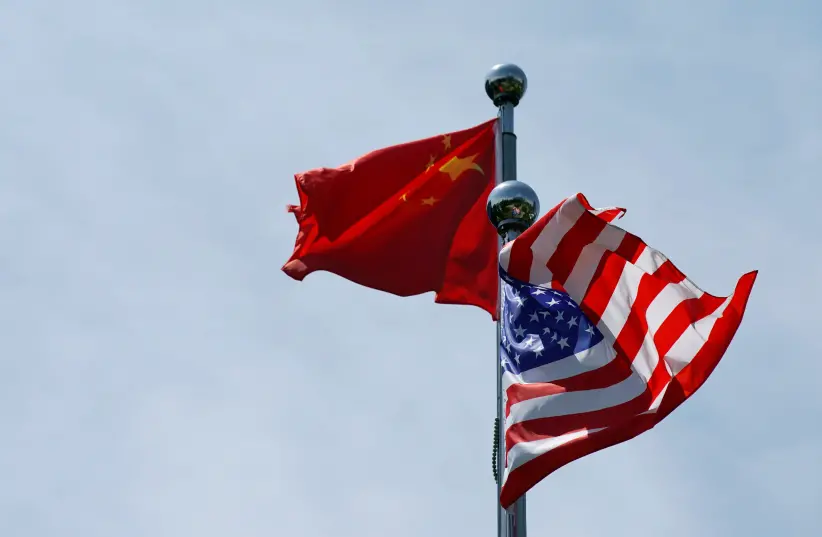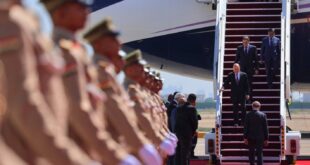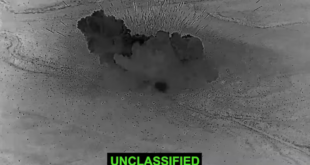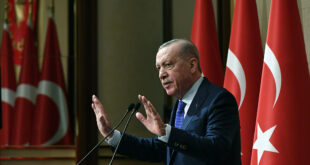This fascinating, disturbing book is relevant for Israel, which must be exceedingly agile to avoid being trampled even by accident by these huge adversaries.
When elephants rumble, the mice at their feet tumble.
Though we Israelis regard our country as an elephant, and act as if it were, Israel is in fact more like a mouse – especially, when its ally America faces off against its rising competitor, China, with which Israel has major economic ties.
This fascinating, disturbing book is relevant for Israel, which must be exceedingly agile to avoid being trampled even by accident by these huge adversaries.
From two former military officers, one of them a former senior admiral (Stavridis), comes this scary geopolitical novel that begins with a naval clash between the US and China in the South China Sea in 2034 – and moves rapidly from there to a global war. Like nearly all wars, the next world war escalates as each side miscalculates the intentions and actions of its foes.
Warning: Reading this book is hair-raising. Here is how it unfolds.
It is 14:47 Eastern Standard Time, Sunday, March 12, 2034. At home in the US, people are coming home from church or finishing their Sunday dinners. In the disputed South China Sea, near the Spratly Islands, US Navy Commodore Sarah Hunt is on the bridge of her flagship, the guided missile destroyer USS John Paul Jones, conducting a routine ‘freedom of navigation’ patrol.
The patrol is a response to the People’s Republic of China claim that the entire South China Sea area, and its oil and gas minerals, are in its territorial waters. The USS John Paul Jones and its 400 sailors, with two destroyers the USS Levin and the USS Hoon, join four other ships that form Squadron 21 of the 7th Fleet. They investigate a trawler, the Wén Rui, which is on fire. After extinguishing the blaze, they discover computers and servers below decks. They take control of the Wén Rui.
Meanwhile, at about the same time, US Marine pilot Major Chris “Wedge” Mitchell is flying an F35E Lightning [known as the “Adir” by the Israeli Air Force, which eventually will have 75 of them] over the Strait of Hormuz, testing a new stealth technology as he flirts with Iranian airspace. He has launched from the nuclear aircraft carrier George H.W. Bush.
It turns out that the Chinese have deployed advanced cyber capability to the Iranian Revolution Guards, as part of the Sino-Iranian alliance. [Note: Iran and China recently signed a 25-year cooperation pact].
“Wedge” is a fourth-generation aviator. His great-grandfather, grandfather and father all were military pilots.
Mitchell suddenly loses control of his plane. The Guards take remote control of the F35E and Mitchell’s plane and land it at the Iranian Bandar Abbas military base, near the Straits of Hormuz. Mitchell is taken prisoner and brutally interrogated.
In Washington, the Chinese defense attaché Admiral Lin Bao shows up at the White House and asks to speak with National Security Advisor Choudhury. Admiral Lin, munching nonchalantly on a package of M&M’s, has a clear message for Choudhury. “Give us back the Wen Rui!”.
In the South China Sea, six Chinese ships surrounding the US Navy ships “unmask” – they shut off their electromagnetic countermeasure technology that hides them from the US radar and appear suddenly on the American ships’ radar. Rear Admiral Ma Quiang, on the Chinese nuclear aircraft carrier Zheng Zhe, repeats Lin’s demand: Release the Wen Rui!
The seven US ships discover that all their communication is down – jammed and disabled by the Chinese. Three of the US Navy ships are sunk. The John Paul Jones is torpedoed but does not sink immediately. It will be scuttled by the US Navy sub that rescues its few remaining survivors, including Commodore Hunt, who faces a board of inquiry.
In Washington, as Lin Bao leaves his meeting with National Security Agency advisor Choudhury, the lights of Washington go out, as China initiates a cyber attack. Washington goes dark – and so does the whole Eastern seaboard. At the White House, administration officials find they are locked out of everything – even the vending machines, hooked up to the Internet, are down.
It emerges that the Wen Rui incident is a crisis fabricated by China, to allow them to strike the US ships in the South China Sea. The trawler’s technology is simply a ruse.
Iran and China have coordinated their moves, which involve the use of powerful new forms of cyber weaponry that render US ships and planes defenseless. In this one incident, in a matter of hours, America’s faith in its expensive military’s technological superiority is destroyed.
Russians cut Internet cables in the Arctic and as a result blind much of the US. Captain Hunt gets a key naval command as a Rear Admiral. She orders her aircraft to go low-tech, using WWII radio technology. The US uses tactical nuclear weapons to destroy part of China’s naval fleet, a dangerous escalation. As the US and China slug it out, the US goes foregoes its technology, blinded by China’s advanced cyber capabilities, and slugs it out with World War II methods.
Almost in an instant, a new era is at hand – and a bitter World War. And there are only losers.
I’d rather not be a spoiler and tell readers how this US-China war turns out. It is not pretty. No war is. The authors avoid moralizing and refrain from a good guy (America) vs. bad guy (China) stance, and instead offer a chilling objective account, driven by military experience in the field, of a future world war scenario.
In the novel, both sides make huge miscalculations, based on misjudging the enemy, and lead the world into a terrible global war. In the end, China and the United States each pay a huge cost – and the world is never the same. The fictional novel 2034 brings us a dark vision of a future that must at all costs be avoided – because, as Einstein once said, World War III may be fought with advanced weapons, but World War IV will then be fought with sticks and stones. . . . . . .
The scenario described in 2034 – war by miscalculation – is eminently plausible for us Israelis. Take for instance the disastrous Second Lebanon War.
The conflict was precipitated by a 2006 Hezbollah cross-border raid. On July 12, Hezbollah fighters fired rockets at Israeli border towns as a diversion for an anti-tank missile attack on two armored patrols on the Israeli side of the border fence. The ambush left three soldiers dead.
Two Israeli soldiers were abducted and taken by Hezbollah to Lebanon. Five more were killed in Lebanon, in a failed rescue attempt. Hezbollah demanded the release of Lebanese prisoners held by Israel in exchange for the release of the abducted soldiers. Israel refused and responded with airstrikes and artillery fire on targets in Lebanon.
Israel attacked both Hezbollah military targets and Lebanese civilian infrastructure, including the Beirut airport. The IDF then launched a ground invasion of Southern Lebanon. Israel also imposed an air and naval blockade on Lebanon. Hezbollah responded and launched more rockets into northern Israel and engaged the IDF in guerrilla warfare.
Miscalculation, escalation – the two ingredients of war.
I asked a true expert on South Asia, my friend Bilahari Kausikan, formerly Director-General of the Singapore Foreign Ministry, for his thoughts on the novel 2034 and its genre. He told me: “I’m not a big fan of this genre — however technically realistic they may be on the military details, they are usually off on the political context. For example almost all fictional US-China war scenarios I know of never convincingly explain how nuclear deterrence breaks down.
“Nuclear deterrence is intrinsically political. The US and the Soviet Union went through some very serious kinetic encounters during the course of the Cold War with servicemen on both sides killed — we only learned about many of them with the declassification of records (mainly American and European) after the Cold War. But deterrence never broke down because political control on both sides did not break down. [Thomas Schelling explained that violence is anticipated and avoided by accommodation; deterrence, the use of the power to hurt, becomes bargaining power and is the foundation of what prevents nuclear war].
“The US and China are both rational so I believe that while accidents could well occur in the East and South China Seas, both sides will work to contain them. The exception is Taiwan. If Taipei makes a dash for formal independence, Beijing must fight whatever the risks.”
Someday, an author may write a more realistic World War Three scenario, in which rash Taiwanese leaders declare independence – and escalation rapidly follows.
China is undoubtedly a rising force in the world, challenging US military hegemony. Chinese leader Xi Jin Ping stated clearly his ambition of building a strong army a month after he took power in 2012. Eight years later, at a policy meeting in October, the Community Party leadership unveiled its plan to build a fully modernized arm by 2027 – the year the People’s Liberation Army will celebrte its 100th birthday. According to many analysts, the goal is to reach equality with the US – at present the world’s strongest fighting force.
In recent years, Beijing’s defense spending has risen sharply. In 2020, a military budget of 1.27 trillion renminbi ($193 billion) was announced, up 6.6 per cent from the previous year and the second highest in the world after the US.
China has long been criticized for its opacity in its defense budgets. For 2019, Beijing claimed its military spending was $176 billion, but the Stockholm International Peace Research Institute estimated it was actually $261 billion. In comparison, the United States spent $732 billion in 2019. However, costs for military manpower and hardware are far lower in China than in the US, so the gap is far smaller.
How will the new Biden Administration strategize its rivalry with China? The website Politico reported in March that “the first high-level meeting between U.S.-Chinese officials under the new Biden administration got off to a chilly start with senior American diplomats accusing China of threatening world stability and Chinese officials alleging America is a human rights hypocrite due to its mistreatment of Black citizens. Afterward, a U.S. official accused the Chinese diplomats of grandstanding.”
Israel, as a ‘mouse’, must be highly agile as the two great powers face off. At present Israel benefits from close ties with both the US and China.
Since 2010, bilateral trade between Israel and China has doubled; in 2019 $11.53 billion in Chinese capital flowed into Israeli tech firms and infrastructure contracts. China is building a new container port in Haifa.
In 2020, Israeli imports from China, excluding diamonds, amounted to $9.44 billion, compared to $8.24 billion in 2019. China has become Israel’s biggest source of imported goods, in contrast to 2019 when the US topped the list. Israeli exports to China were $4.11 billion in 2020.
While reading 2034, I thought about British historian Arnold Toynbee’s book A study of History: Challenge and Response. Toynbee analyzes history as the process in which civilizations rise and fall when they face extreme challenges and respond well or poorly.
The current global pandemic is a prime example. Some countries have responded well. Many have not. COVID-19 has reshuffled the rank orders of successful and failed nations.
Toynbee argued that nations nearly always die from ‘suicide’ — internal disorder and conflict – not from murder. He wrote, “Man achieves civilization, not as a result of superior biological endowment or geographical environment, but as a response to a challenge in a situation of special difficulty which rouses him to make a hitherto unprecedented effort.”
Israel was born through a near-impossible Herculean effort by a mere handful of people. And again it faces major challenges. The US, China, and Israel all will write their future histories, less by how they manage armed conflicts with enemies, than by how they respond to domestic challenges and strategize their civil society internally. Perhaps there is some small comfort in this knowledge, after reading the terrifying scenario in 2034.
It is up to us. As Walt Kelly’s cartoon strip character Pogo observed ungrammatically, ‘we have met the enemy …and they is us.’
 Eurasia Press & News
Eurasia Press & News



